Family: Tenthredinidae
Family common name: common sawflies
Subfamily: Selandriinae
Tribe: Strongylogastrini
Genus: Thrinax Konow, 1885
Subgenera: none
The Tenthredinidae are the most species-rich family and are found throughout the world, in all continents but Antarctica. They are known as the “common sawflies.” They can generally be recognized by a cylindrical body and long, segmented antennaeantenna:
the sensory organ emerging from the front of the head, usually between the compound eyes and above the clypeus; includes the flagellum, scape and pedicel
 . Otherwise, they come in a variety of colors, sizes, and forms (Goulet 1992Goulet 1992:
. Otherwise, they come in a variety of colors, sizes, and forms (Goulet 1992Goulet 1992:
Goulet H. 1992. The genera and subgenera of the sawflies of Canada and Alaska: Hymenoptera. Symphyta. The insects and arachnids of Canada. Part 20. Agriculture Canada Publication.).
Sawflies in the Selandriinae subfamily are relatively small and slender. The range of Selandriinae is worldwide, it occurs on all continents except Antarctica (Goulet 1992Goulet 1992:
Goulet H. 1992. The genera and subgenera of the sawflies of Canada and Alaska: Hymenoptera. Symphyta. The insects and arachnids of Canada. Part 20. Agriculture Canada Publication.). It is the most common and diverse group of tenthredinids in tropical regions, particularly in Central America, South America, and Southeast Asia (Smith 1969eSmith 1969e:
Smith DR. 1969e. Nearctic Sawflies. II. Selandriinae: Adults (Hymenoptera: Tenthredinidae). Technical Bulletin, U.S. Department of Agriculture 1398: 1-48.). Selandriinae contains the only known sawflies that feed on non-vascular plants, specifically ferns (Smith et al. 2013Smith et al. 2013:
Smith DR, Janzen DH and Hallwachs W. 2013. Food plants and life histories of sawflies of the families Argidae and Tenthredinidae (Hymenoptera) in Costa Rica, a supplement. Journal of Hymenoptera Research 35: 17-31. https://doi.org/10.3897/JHR.35.5496).The subfamily can be distinguished from other subfamilies by wing venationvenation:
the network of veins on a wing
(Goulet 1992Goulet 1992:
Goulet H. 1992. The genera and subgenera of the sawflies of Canada and Alaska: Hymenoptera. Symphyta. The insects and arachnids of Canada. Part 20. Agriculture Canada Publication.).
Thrinax are medium-sized, about 7 mm in length, and generally black and white in color with orange/red legs. The genus is fern-feeding (Smith 1969eSmith 1969e:
Smith DR. 1969e. Nearctic Sawflies. II. Selandriinae: Adults (Hymenoptera: Tenthredinidae). Technical Bulletin, U.S. Department of Agriculture 1398: 1-48.).
There are 27 described extantextant:
in existence; opposite of extinct
species worldwide. Four occur in North America (Taeger et al. 2010Taeger et al. 2010:
Taeger A, Blank SM, and Liston AD. 2010. World Catalog of Symphyta (Hymenoptera). Zootaxa 2580: 1-1064.).
A key to NearcticNearctic:
describing the region of the Northern Hemisphere that includes North America south through northern Mexico
 species of Thrinax (as Hemitaxonus) is included in Smith 1969eSmith 1969e:
species of Thrinax (as Hemitaxonus) is included in Smith 1969eSmith 1969e:
Smith DR. 1969e. Nearctic Sawflies. II. Selandriinae: Adults (Hymenoptera: Tenthredinidae). Technical Bulletin, U.S. Department of Agriculture 1398: 1-48..
Subfamily characters
 vein Rs+M curved near intersection with veinvein:
vein Rs+M curved near intersection with veinvein: Sc+R (Smith 1969eSmith 1969e:
Sc+R (Smith 1969eSmith 1969e: veins M and m-cu about parallel (Smith 1969eSmith 1969e:
veins M and m-cu about parallel (Smith 1969eSmith 1969e: vein 2r-m present (Goulet 1992Goulet 1992:
vein 2r-m present (Goulet 1992Goulet 1992:Genus characters
 as long as wide (Smith 1969eSmith 1969e:
as long as wide (Smith 1969eSmith 1969e: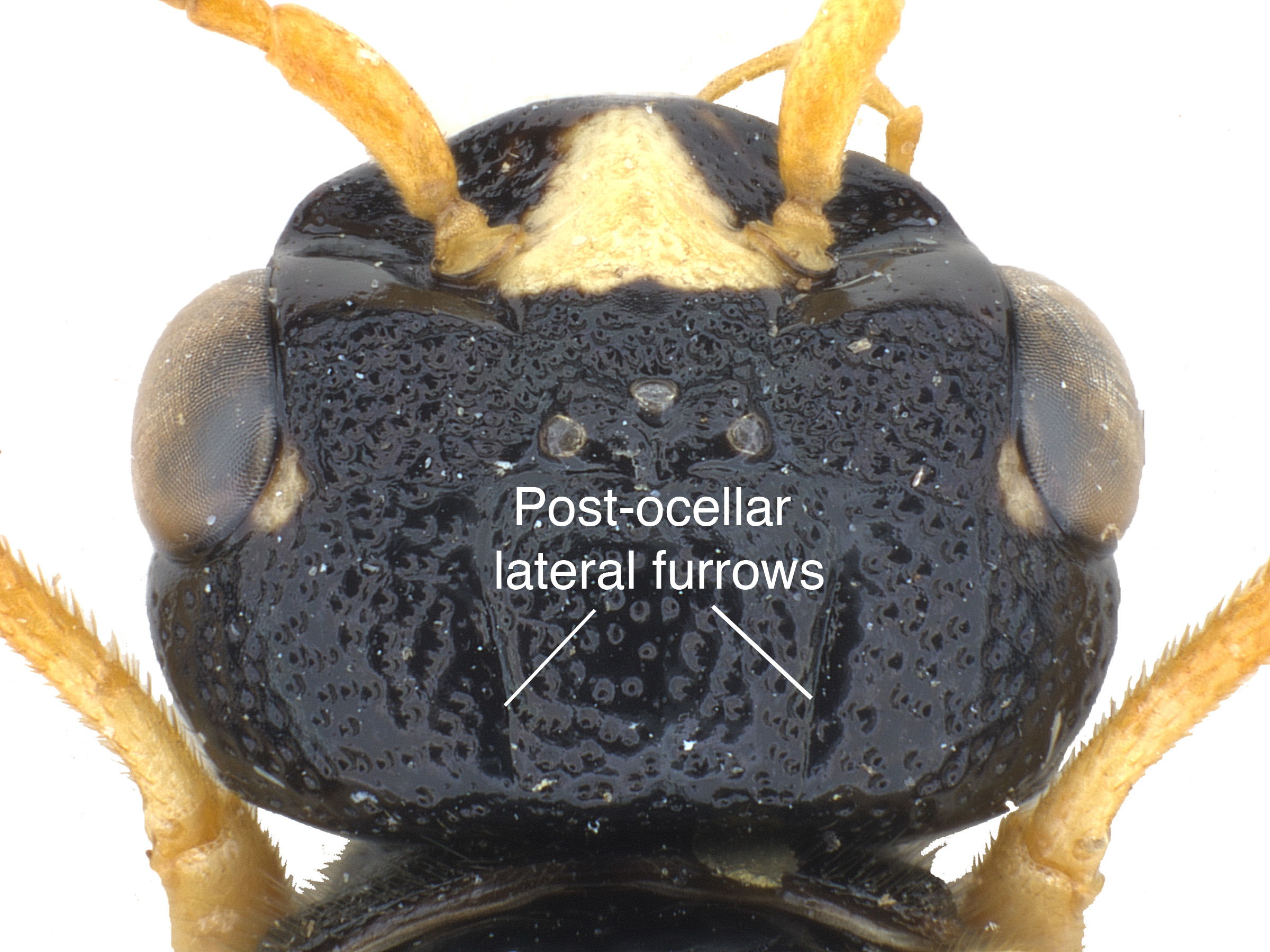 present and fairly straight, not V-shaped (Goulet 1992Goulet 1992:
present and fairly straight, not V-shaped (Goulet 1992Goulet 1992: vein M meeting Sc+R at intersection of Rs+M and Sc+R (Smith 1969eSmith 1969e:
vein M meeting Sc+R at intersection of Rs+M and Sc+R (Smith 1969eSmith 1969e: anal cellanal cell:
anal cellanal cell: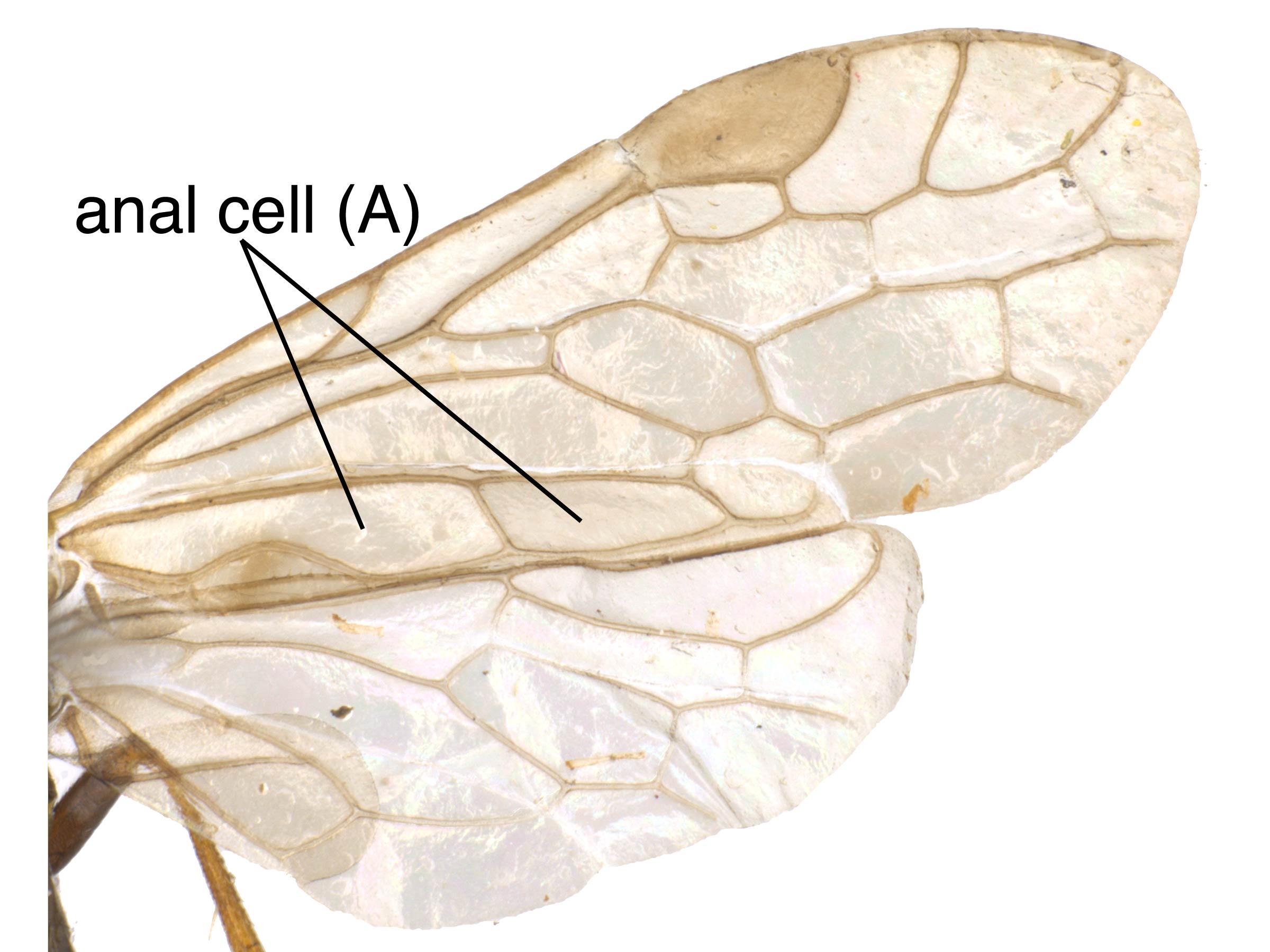 with almost perpendicular crossveincrossvein:
with almost perpendicular crossveincrossvein: anal crossveinanal crossvein:
anal crossveinanal crossvein: (Goulet 1992Goulet 1992:
(Goulet 1992Goulet 1992: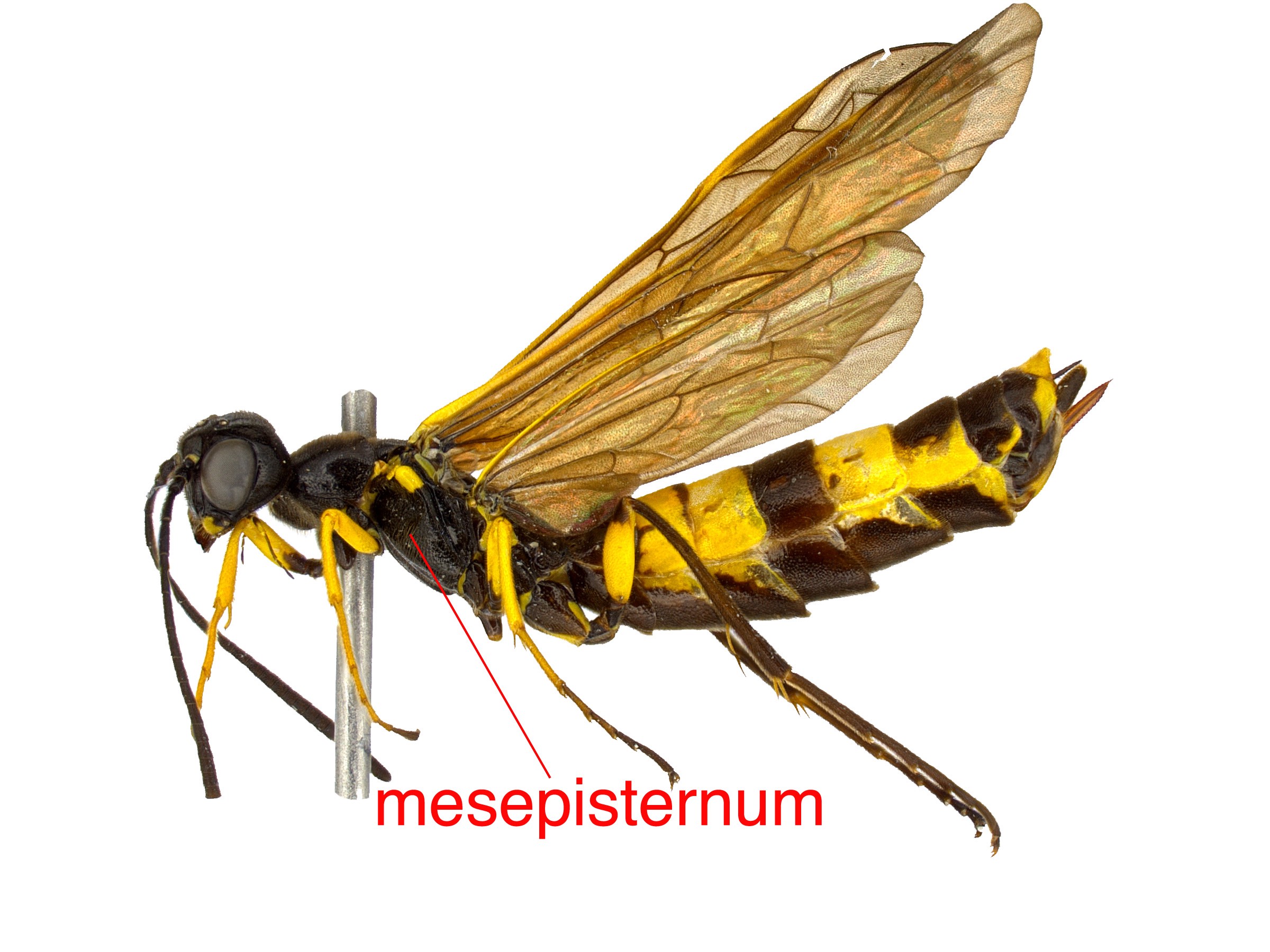 (Goulet 1992Goulet 1992:
(Goulet 1992Goulet 1992: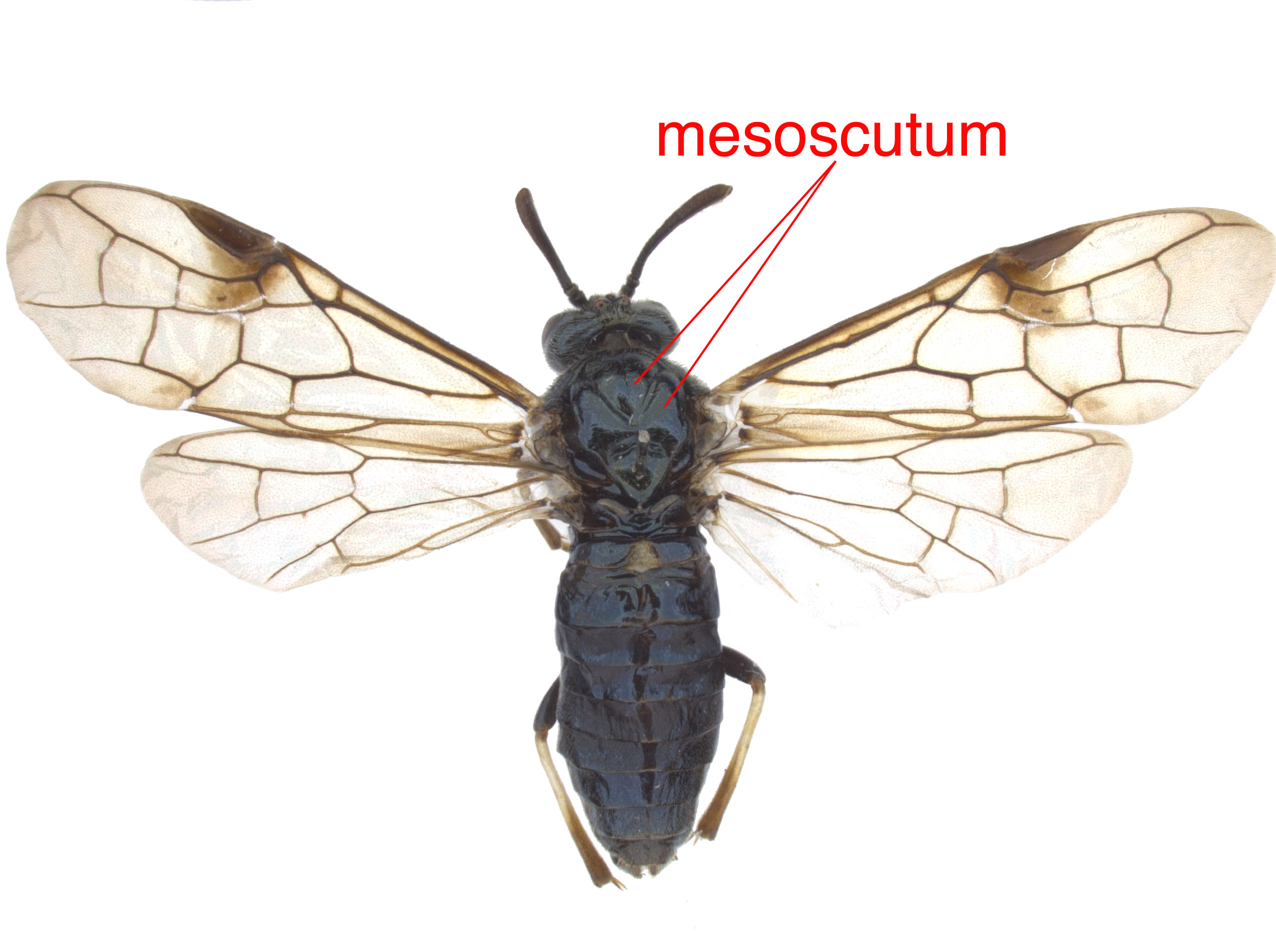 laterallateral:
laterallateral: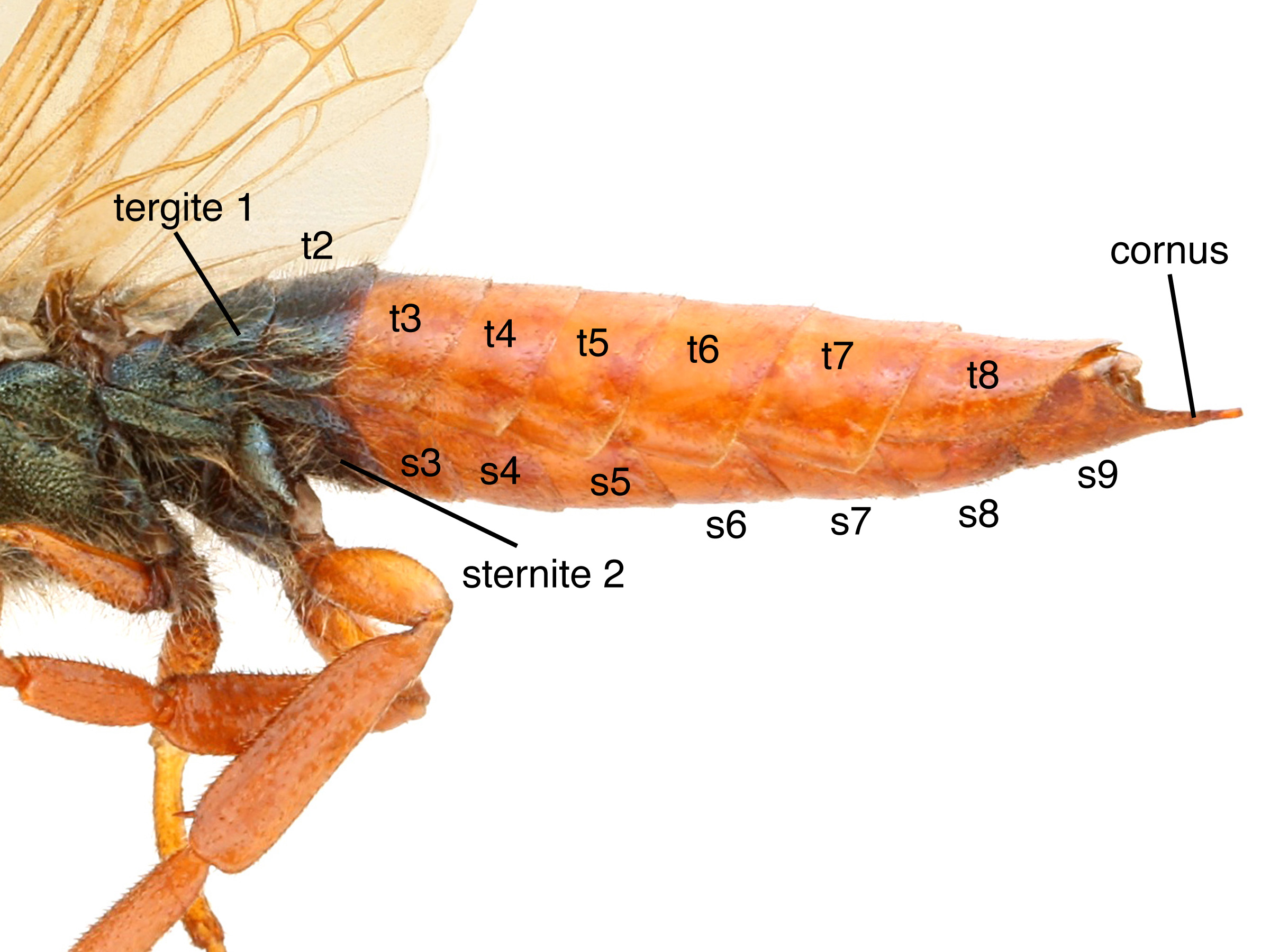 wide medially with narrow membranous area (Goulet 1992Goulet 1992:
wide medially with narrow membranous area (Goulet 1992Goulet 1992:Thrinax can be confused with similar species in the subfamily Selandriinae or tribe Strongylogastrini. It can be distinguished from most other genera by the perpendicular anal crossveinanal crossvein:
a crossvein that goes through the center of the basal anal cell
, from closely related Eriocampidea by slender antennaeantenna:
the sensory organ emerging from the front of the head, usually between the compound eyes and above the clypeus; includes the flagellum, scape and pedicel
 and presence of occipitalocciput:
and presence of occipitalocciput:
the posterior surface of the head
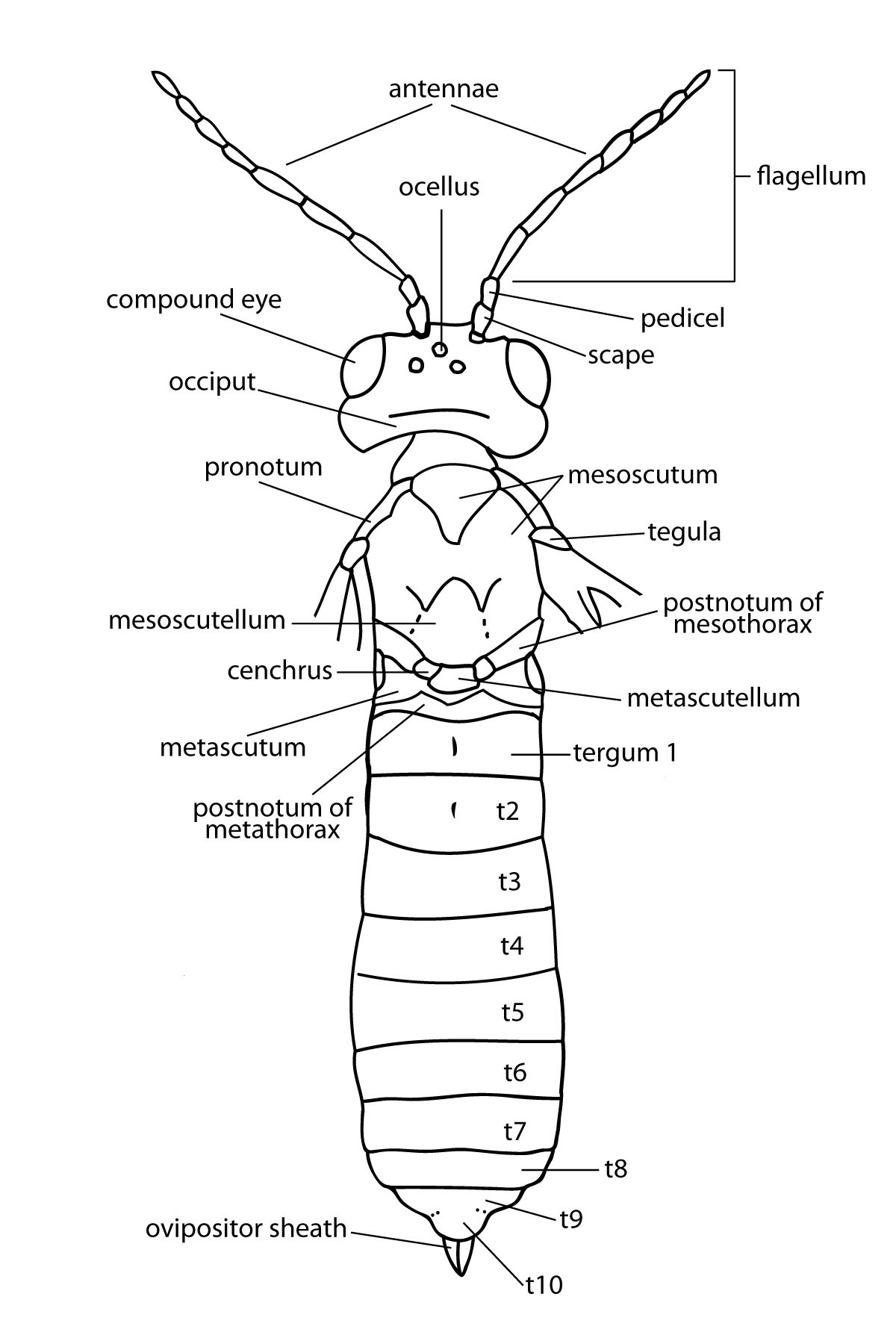 ridge, and from closely related Strongylogaster by the length of the pedicelpedicel:
ridge, and from closely related Strongylogaster by the length of the pedicelpedicel:
the second antennal segment, between the scape and flagellum
 (Smith 1969eSmith 1969e:
(Smith 1969eSmith 1969e:
Smith DR. 1969e. Nearctic Sawflies. II. Selandriinae: Adults (Hymenoptera: Tenthredinidae). Technical Bulletin, U.S. Department of Agriculture 1398: 1-48.).
none
In North America, Thrinax feeds on ferns, including Athyrium (lady fern), Athyrium thelypteroides (silver glade fern), Onoclea sensibilis (sensitive fern), Osmunda, Pteridium (bracken fern), and Matteuccia (ostrich fern) (Smith 1966aSmith 1966a:
Smith DR. 1966a. The Nearctic sawflies of the genus Hemitaxonus Ashmead (Hymenoptera: Tenthredinidae). Proceedings of the Entomological Society of Washington 68(2): 113-120., Goulet 1992Goulet 1992:
Goulet H. 1992. The genera and subgenera of the sawflies of Canada and Alaska: Hymenoptera. Symphyta. The insects and arachnids of Canada. Part 20. Agriculture Canada Publication.).
Specific biology of this genus is not known. Female Thrinax lay eggs onto the upper side of the leaf in groups up to 12 per leaf. LarvaeLarva:
the immature stage of holometabolous insects
 feed externally and then overwinter in wood or pith of a nearby plant (Smith 1969eSmith 1969e:
feed externally and then overwinter in wood or pith of a nearby plant (Smith 1969eSmith 1969e:
Smith DR. 1969e. Nearctic Sawflies. II. Selandriinae: Adults (Hymenoptera: Tenthredinidae). Technical Bulletin, U.S. Department of Agriculture 1398: 1-48.).
World: This genus is known from North America and East Asia (Taeger et al. 2010Taeger et al. 2010:
Taeger A, Blank SM, and Liston AD. 2010. World Catalog of Symphyta (Hymenoptera). Zootaxa 2580: 1-1064.). One species occurs in Europe (Blank 2002Blank 2002:
Blank SM. 2002. Taxonomic notes on Strongylogasterini (Hymenoptera: Tenthredinidae). Proceedings of the Entomological Society of Washington 104 (3): 692-701.).
North America: Three species of Thrinax are eastern in distribution, found in eastern Canada and in the United States east of the Mississippi River. Thrinax primaria occurs in British Columbia, Oregon, and California (Smith 1969eSmith 1969e:
Smith DR. 1969e. Nearctic Sawflies. II. Selandriinae: Adults (Hymenoptera: Tenthredinidae). Technical Bulletin, U.S. Department of Agriculture 1398: 1-48.).
Map data from: GBIF.org (29 October 2019) GBIF Occurrence Download Thrinax
Details about data used for maps can be found here.